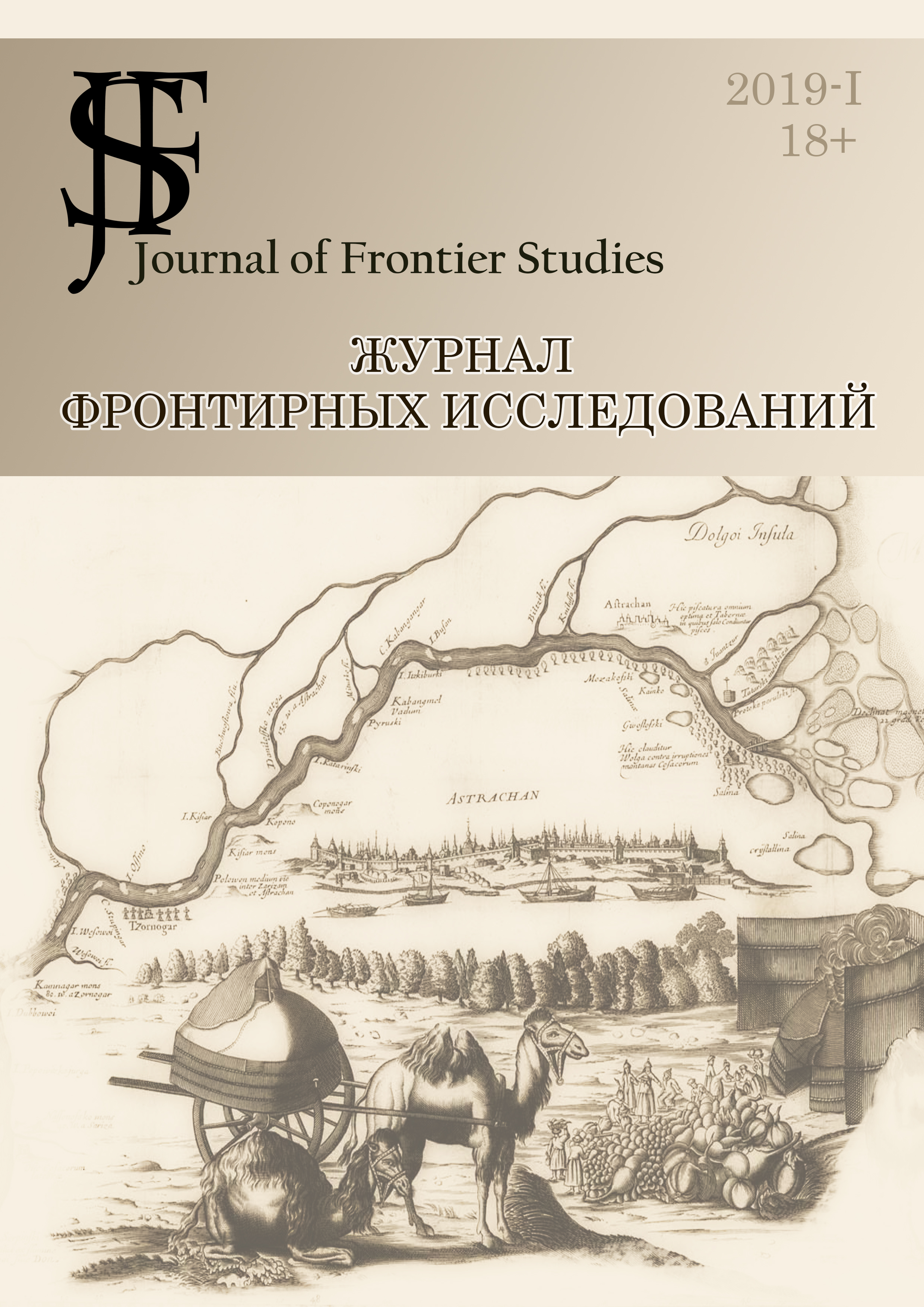Abstract
This article is devoted to the problem of the Other as a factor in the formation of the boundaries of identity in the Middle Ages. Exploring this problem through the prism of the analysis of literary and artistic works of the epoch, the author of the article examined the concept of otherness in two planes: imaginary and real. Having identified the main imaginary concept of the Alien, manifested in the image of the Monster, the author concluded that the latter is the quintessence of otherness, and determined the boundary of the Middle Ages man in the binary model of the Universe (good/evil, divine/impious). This identity, according to the author, was manifested in the constant attempt to typologize monsters through nomination, thereby identifying the monster as recognizable, and therefore less dangerous.
The real Other in the Middle Ages was embodied in the image of the Muslims (Saracen). The author notes that this image was also monstrous in the minds of a medieval European citizen. At the same time, the author claims that the real Other was stigmatized by the markers of the monstrosity that transferred him from the category of reality to the imaginary plane.
Summarizing her research, the author comes to the conclusion that in both cases of the meeting of a Medieval person with the Other, the latter plays an important role in shaping the boundaries of the identity of the first through a number of important processes: nomination, endowing with certain markers of otherness and defining the Other through the category of unnatural, antagonistic to the human beings.
References
Bynum, C. (1995). Why All the Fuss about the Body? A Medievalist's Perspective. Critical Inquiry, 22(1), 1-33.
Daniel, N. (1975). The Arabs and Mediaeval Europe. London: Longman.
Derrida, J. (1995). Points: Interviews, 1974–1994. Stanford: Stanford University Press.
Foucault, M. (1984). The Subject and Power. Art After Modernism: Rethinking Representation. New York: New Museum of Contemporary Art.
Friedman , J. B. (1981). The Monstrous Races in Medieval Art and Thought. Cambridge, MA: Harvard University Press.
Isidore of Seville. (1964). Etymologies. The Medical Writings. Philadelphia.
Jones, C. M. (1942). The Conventional Saracen of the Songs of Geste. Speculum(17), 205.
Kristeva, J. (1982). Powers of Horror: An Essay on Abjection. New York: Columbia University Press.
Lionarons, J. T. (1996). Beowulf: Myth and monsterS. English Studies(77), 1-14.
Migne, J.-P. (1844-91). Patrologice cursus completus: Series latino.
Mittman, A. S. (2006). Maps and Monsters in Medieval England. NY and London: Routledge.
Norman, D. (1960). Islam and the West: The Making of an Image. Edinburgh: Edinburgh University Press.
Orchard, A. (1995). Pride and Prodigies: Studies in the Monsters of the Beowulf Manuscript. Toronto: University of Toronto Press.
Roger of Hoveden. (1853). The Annals of Roger of Hoveden. (H. T. Riley, Trans.) London: Bohn.
Sopper, K. (1995). What is Nature? Culture, Politics and the Non-human. Oxford: Blackwell.
Southern, R. W. (1962). Western Views of Islam in the Middle Ages. Cambridge: Harvard University Press.
White, D. G. (1991). The Myths of the Dog-Man. Chicago: University of Chicago Press.
Гай, Ю. С. (1996). Собрание достопамятных сведений. В Знание за пределами науки. Мистицизм, герметизм, астрология, алхимия, магия в интеллектуальных традициях I-XIV вв. М.: Республика.
Лучицкая, С. И. (2001). Образ Другого: мусульмане в хрониках Крестовых походов. СПб: Издательство «Алетейя».
Романова, А. П. (2015). Амбивалентность образа монстра в современной культуре: дихотомия «Свой-Чужой». Евразийский союз ученых(10), 52–54.
Романова, А. П., Якушенков, С. Н., Хлыщева, Е. В., Канатьева, Н. С., Якушенкова, О. С., Топчиев, М. С., . . . Морозова, Е. В. (2018). Многоликий Другой. Инвариантность образов Другого/Чужого. Астрахань: Издатель: Сорокин Роман Васильевич.
References
Bynum, C. (1995). Why All the Fuss about the Body? A Medievalist's Perspective. Critical Inquiry, 22(1), 1-33.
Daniel, N. (1975). The Arabs and Mediaeval Europe. London: Longman.
Derrida, J. (1995). Points: Interviews, 1974–1994. Stanford: Stanford University Press.
Foucault, M. (1984). The Subject and Power. Art After Modernism: Rethinking Representation. New York: New Museum of Contemporary Art.
Friedman, J. B. (1981). The Monstrous Races in Medieval Art and Thought. Cambridge, MA: Harvard University Press.
Isidore of Seville. (1964). Etymologies. The Medical Writings. Philadelphia.
Jones, C. M. (1942). The Conventional Saracen of the Songs of Geste. Speculum(17), 205.
Kristeva, J. (1982). Powers of Horror: An Essay on Abjection. New York: Columbia University Press.
Lionarons, J. T. (1996). Beowulf: Myth and monsterS. English Studies(77), 1-14.
Migne, J.-P. (1844-91). Patrologice cursus completus: Series latino.
Mittman, A. S. (2006). Maps and Monsters in Medieval England. NY and London: Routledge.
Norman, D. (1960). Islam and the West: The Making of an Image. Edinburgh: Edinburgh University Press.
Orchard, A. (1995). Pride and Prodigies: Studies in the Monsters of the Beowulf Manuscript. Toronto: University of Toronto Press.
Roger of Hoveden. (1853). The Annals of Roger of Hoveden. (H. T. Riley, Trans.) London: Bohn.
Sopper, K. (1995). What is Nature? Culture, Politics and the Non-human. Oxford: Blackwell.
Southern, R. W. (1962). Western Views of Islam in the Middle Ages. Cambridge: Harvard University Press.
White, D. G. (1991). The Myths of the Dog-Man. Chicago: University of Chicago Press.
Guy, Yu. S. (1996). Collection of memorable information. In Knowledge beyond science. Mysticism, hermeticism, astrology, alchemy, magic in the intellectual traditions of the I-XIV centuries. M.: Republic.
Luchitskaya, S.I. (2001). Image of the Other: Muslims in the chronicles of the Crusades. St. Petersburg: Aletheia Publishing House.
Romanova, A. P. (2015). The ambivalence of the image in modern culture: the dichotomy of "Ours - the Other". Eurasian Union of Scientists (10), 52–54.
Romanova, A. P., Yakushenkov, S. N., Khlyscheva, E. V., Kanateva, N. S., Yakushenkova, O. S., Topchiev, M. S… Morozova, E. V. (2018). The Other with Many Faces: Invariance of images of the Other. Astrakhan: Publisher: Sorokin Roman Vasilyevich.

This work is licensed under a Creative Commons Attribution-NonCommercial-NoDerivatives 4.0 International License.

